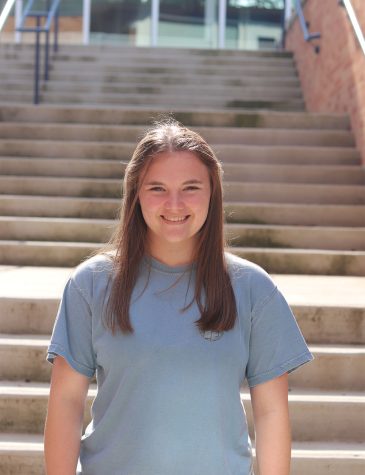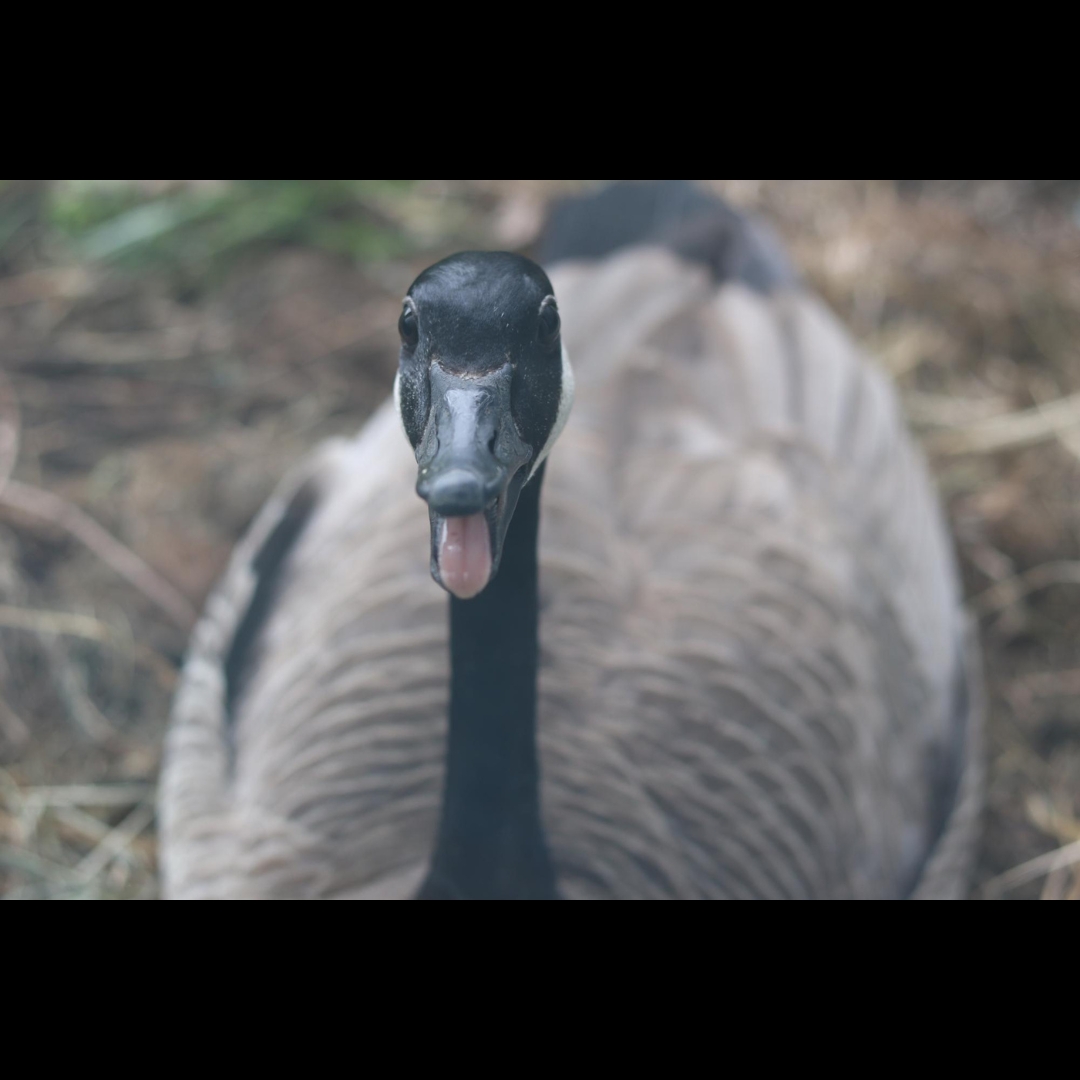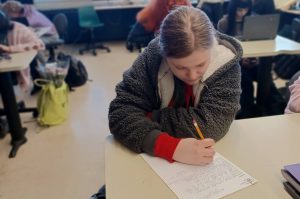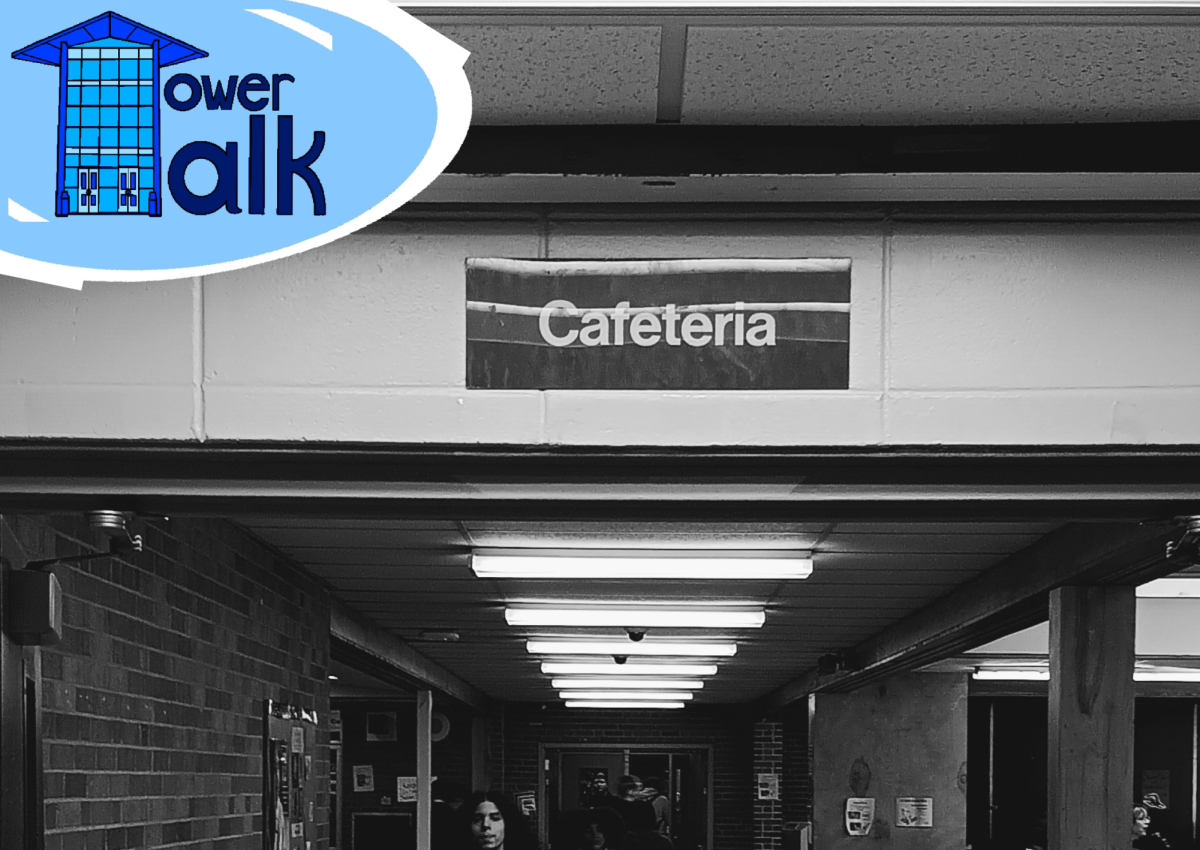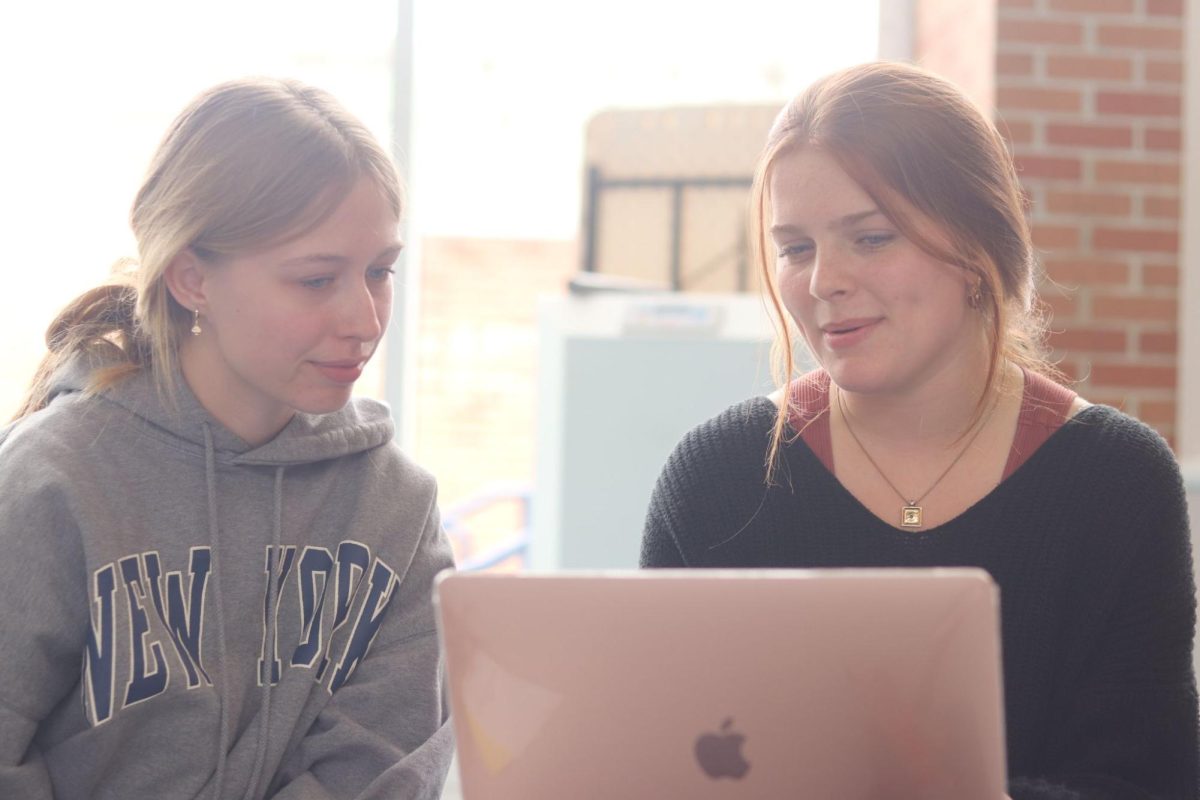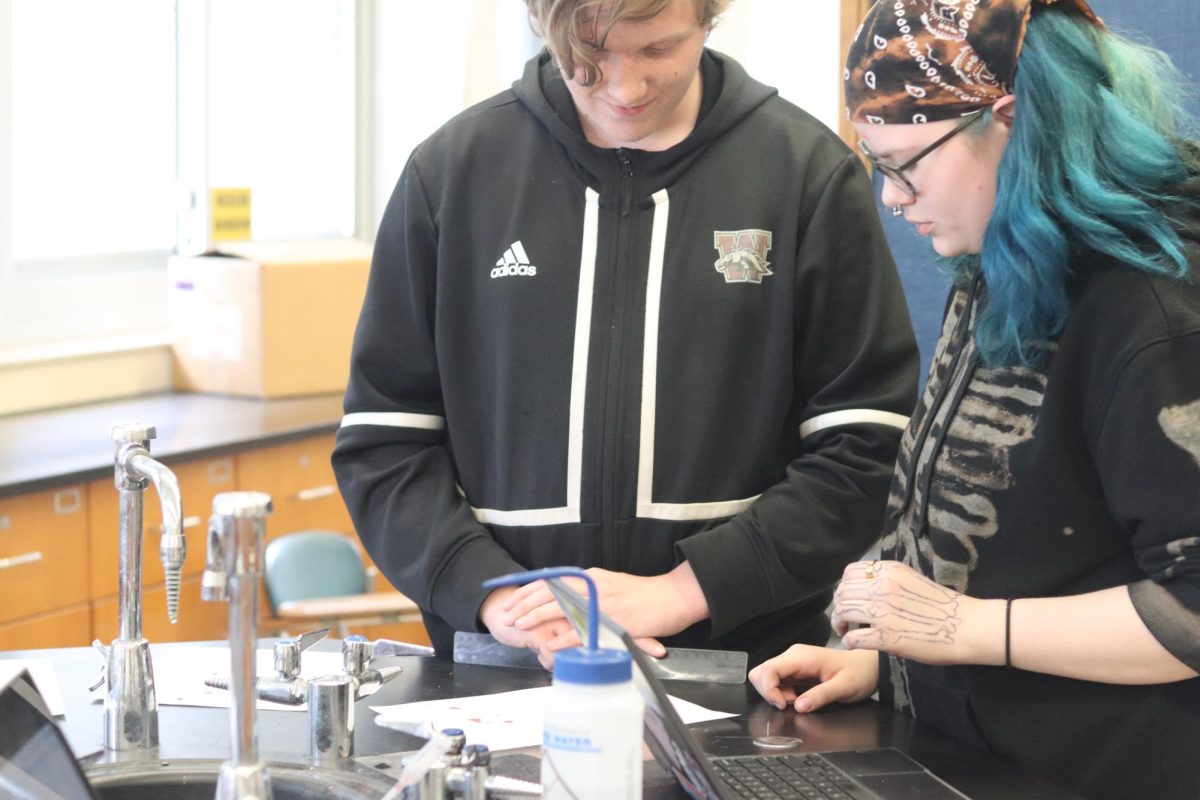Restorative justice: Loy Norrix gradual implementation is a small step in the right direction, but is it enough to create systemic change?
Credit: Hannah Locke
Jason Walker talks to students in the hallway. Walker is the restorative justice coach at Loy Norrix and works with students and staff when conflict arises.
February 14, 2022
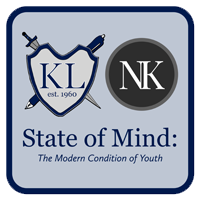 Editor’s note: This story is part of “State of Mind: The Modern Condition of Youth,” produced in partnership with local, independent news outlet NowKalamazoo, which provided editorial support and guidance.
Editor’s note: This story is part of “State of Mind: The Modern Condition of Youth,” produced in partnership with local, independent news outlet NowKalamazoo, which provided editorial support and guidance.
In 2019, records showed that, from August to October, there were 747 suspensions in Kalamazoo Public Schools. In 2021, most recently, records showed 571 suspensions over the same period of time. The year in between, which was virtual, resulted in one suspension; an expected low number when considering online education’s isolation of students from one another.
In an effort to reduce harsh disciplinary practices and help students learn from their conflicts, the KPS district has begun to use other modes of intervention to solve student issues in place of and in addition to removal from the classroom. These efforts in restorative justice could be responsible for the decrease in suspensions in the 2021 school year.
Restorative justice is a method of conflict resolution where students or staff who are involved in altercations with one another go through a more communicative process that involves asking and answering questions and gauging whether or not the issue can be resolved in a manner more conducive to the student’s education.
In an interview with News Channel 3, KPS superintendent Dr. Rita Raichoudhuri said, “This year, we want suspensions to be a last resort because we don’t want students to be removed from learning environments because that doesn’t serve anybody.”
In a Knight Life interview, LN principal Christopher Aguinaga agreed.
“It doesn’t benefit the kid. So, ultimately, if we do use it [suspension], my goal would be to use it as sparingly as possible and try to be measured with how much of it we use. So, for example, can we find alternatives to suspension, like detention or community service, is a big one we are trying to ramp up,” said Aguinaga.
Suspension numbers also stem from a deeper systemic issue: the use of zero-tolerance policies such as suspensions disproportionately affect students of color, low-income students, LGBTQ+ students and students with disabilities.
According to Miseducation, a compilation of Civil Rights data from the U.S. Department of Education, from ProPublica, “Black students were 5.1 times more likely to be suspended as white students” and “Hispanic students were 2.1 times more likely to be suspended as white students” from Loy Norrix in 2018.
As well as the disproportionate effects on marginalized students, suspensions and expulsions have lasting effects on students that go beyond their high school education.
According to the ACLU, “Students suspended or expelled for a discretionary violation are nearly three times more likely to be in contact with the juvenile justice system the following year.”
In an attempt to lessen the systemic problems that zero-tolerance policies perpetuate, former Michigan Governor Rick Snyder signed a law in 2016 that requires Michigan schools that requires Michigan schools take into account home life and personal factors, as well as whether the student would benefit from alternatives to suspension, before resorting to zero-tolerance policies.
Gryphon Place has been a large catalyst in Kalamazoo for the implementation of restorative justice in KPS schools. This mental health service supplies restorative justice training and has programs in schools. Norrix is one of the schools at which these programs take place: restorative justice facilitators are at the school two to three times a week and often handle non-violent conflict and peer mediation through restorative conferences.
Susannah Parr, a restorative justice facilitator who works with LN through the Gryphon Place restorative justice program said, “Because of the severity of the potential long- term effects of suspension, if it continues to have a place in schools, it should be used as an absolute last resort, only when people are at risk of serious harm. We need tools beyond suspension. Students need additional, non-punitive support in order to address what is happening in their lives and facilitate healthy relationships and connections.”
Parr continued, “Our role is to work with students, teachers, and staff who are in conflict with each other and give them an opportunity to communicate directly about harm that’s been done and find solutions that work for everyone to move forward.”
Another resource at Norrix is Jason Walker, the restorative justice coach, who holds a permanent position and is in the building five days a week. Walker deals with violent conflicts or other serious altercations that may lead to violence.
Aguinaga said, “Restorative is being used in kind of two ways: one is as a preventative measure for students who are having conflict before it boils over into physical violence…the whole idea is that we want to prevent something before it occurs. The other way we use [restorative justice] would be in terms of reducing suspension and also as a re-entry from suspension.The other thing is, because we have that option, we can reduce the number of days of suspension.”
According to the Restorative Practices Implementation Guide from MIRPTC.org, “Restorative practices include affective statements, restorative questions, pro-active circles, responsive circles and restorative meetings/conferences.” All initiatives used are dependent on the student(s) and the infraction(s).
Norrix most regularly implements affective statements and restorative questions when going through the restorative justice process.
Restorative justice coach Jason Walker said, “The process is pretty straightforward.”
The beginning steps are often the same when students participate in the restorative justice process.
“We have a set of questions that we ask everybody,” Walker explained. “I review those questions [student answers] and generally prompt them to give me more of a response: students are not fond of writing for the sake of writing.”
The questions students answer are as follows: What happened? What were you thinking about at the time? What have you thought about since? Who has been affected by what you have done? How have they been affected? What do you think you need to do to make things right?
“Once we’ve done that, I try to assess how comfortable they are dealing with their conflict, basically how angry they still may be.” Walker continued, “So, basically, trying to assess their willingness to compromise or to interact with another person and then, if I feel like it would be productive, we bring the two folks together.”
If students are suspended for a conflict, whether it be because of a violent or non-violent altercation, the restorative justice practice occurs after they return to school, as an effort to reintroduce them to the educational environment.
Walker said, “Then our goal is what’s called a mediation agreement, and the students list basically what they need from the other person in order to be able to interact with them in a positive way—not be their best friend or seek them out for advice—but just be able to be around them.”
This process may be successful in finding the root of the conflict and help to heal relationships between students, but it should also be considered that the root of the conflict may not be the root of the true problem. Students act out for many different reasons; trauma at home, mental health issues, trouble with school, etc. If these factors are neglected then the conflict between students may be resolved, but severe problems that students are still dealing with will continue to fester.
“By espousing restorative justice as a solution, we treat the immediate symptom—student ‘misbehavior’—and neglect the disease that breeds it: health inequity,” wrote MPH candidate Floriana Milazzo in the article “We know the school-to-prison pipeline is a public health crisis, so why is restorative justice disparate from health justice?” from Washington University’s Institute of Public Health.
“Health justice is accessible, equitable, and sustainable care that erodes racist systems underpinning the social determinants of health,” Milazzo wrote.
In order to achieve health justice, rather than grouping students together who have a diversity of problems and experiences that may not align with one another, students would be directed to sufficiently funded community health organizations that are able to give them the resources they need to treat and heal the underlying mental health conditions that are causing their behavioral issues in the first place.
This next step to be taken—the integration of health justice in Kalamazoo Public Schools—is necessary, but with the troubling atmosphere brought on by COVID, social media, and increasing violence, the lack of resources necessary to address the root of all student misbehavior must be taken into consideration.
“We’re all kind of in this adjustment phase. This looks very different, we all look very different with our masks,” Walker said. “So there is a lot of extra communication that we’re not used to doing.”
“Right now, the largest resource we need but that we have the least of is time Our students need, you know, to be scaffolded back into their appropriate educational level because they lost so much time, right, so we’re not only trying to move forward but we are trying to rebuild while moving forward,” Walker said.
In addition to the tumultuous time that this generation of high school students has found themselves in, there are a number of complex factors that must be considered when deciding disciplinary measures.
It is required under the Michigan Revised School Code and the Kalamazoo Public Schools Code of Conduct that certain factors are considered before a student is suspended or expelled.
According to the Kalamazoo Public Schools code of conduct, “These factors include: 1) the pupil’s age; 2) the pupil’s disciplinary history; 3) whether the pupil is a pupil with a disability; 4) the seriousness of the violation or behavior; 5) whether the violation or behavior of the pupil threatened the safety of any pupil or staff member; 6) whether restorative practices will be used to address the violation or behavior; and 7) whether a lesser intervention would address the violation or behavior committed by the pupil.”
“Unfortunately, there is [a place for suspension as punishment]. For safety of staff and for safety of students, there are some times that we need to remove kids from the building,” Aguinaga said. “Sometimes we have to remove students from the building while we investigate something because we can’t have additional violence occur and sometimes it’s the method of last resort. It is not our first choice to do, but unfortunately there are limited tools that we have and that is still one of them. “
With the extra time necessary for conflict resolution, now that KPS students and faculty alike have gone through the trauma of the pandemic and a year of virtual learning, resources are limited. These factors have led to more conflict, and in order to prevent that conflict from happening, a solution may present itself by way of classroom instruction to prepare students for dealing with conflict as it arises.
“We’ve got seventh graders who are now ninth graders, so we are trying to learn what works and what doesn’t work,” Walker said. “So in my position, I would much rather be in the classrooms educating students who don’t need restorative justice on what those skills are before you need them. It’s no good to have to survive in the woods for two weeks and then have someone give you a wilderness survival book after you’re there.”
By teaching all students about conflict resolution in the classroom, they are better suited to deal with even their minor conflicts in a productive way before they become worse.
Parr said, “Restorative justice works best when it is fully integrated into our lives, so it can always be implemented more, in many different creative ways!”
These efforts to lessen the number of punitive, zero-tolerance punishments and address student misbehavior are important, but they do not mean that the disciplinary process has changed completely for the better. By praising restorative justice initiatives exclusively, there is another aspect of conflict resolution that is ignored.
“When restorative justice ends with facilitators holding ‘talking spaces,’ it is exclusion in disguise. We restore a failing system. When restorative justice is an extension of health justice, it is transformative. We sustainably heal,” Milazzo wrote.
When restorative justice is used by itself to resolve conflict between people, then surface-level issues may be remedied – two students no longer get into fights with one another, a friendship is fixed after a miscommunication – but the resolution of these specific issues does not mean that the root of conflict as a whole is fixed.
With the increasing implementation of restorative justice in Kalamazoo Public Schools, we find ourselves moving in the right direction, but without providing affected students with individualized, professional diagnosis, treatment and healing, schools and administrations will find themselves at a standstill.



